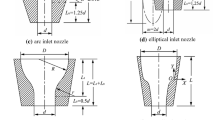Abstract
A water-jet nozzle is widely used on a water-jet loom to carry thread from one side of the loom to the other. The nozzle performance is important for the loom design and is measured in terms of the water drag force. A computational approach is proposed to design and optimize a water-jet nozzle using the design of experiment (DOE) method. Computations were carried by solving the incompressible Navier-Stokes equations with the standard k-ε turbulence model. ANSYS Fluent software was used to solve the fluid flow with Minitab software, which was used for optimization of the geometric parameters. The computational results show that the optimized nozzle has better performance than the original nozzle. The computational optimization approach was experimentally confirmed to be useful in designing a water-jet nozzle for water-jet looms.
Similar content being viewed by others
References
S. Adanur, Handbook of Weaving, CRC Press (2000).
A. C. Bullerwell and M. H. Mohamed, Measuring beat–up force on a water jet loom, Textile Research Journal, 61 (1991) 214–222.
R. M. Dawson, Shed geometry and weft insertion on the water–jet loom, Journal of Textile Institution, 76 (1985) 1–10.
K. Toshiyasu, Weaving machinery and its related technologies, Journal of Textile Engineering, 53 (2) (2007) 43–52.
L. Xiangium, L. Dingding and F. Zhihu, Structural optimization of the main nozzle in an air–jet loom based on orthogonal test method, Journal of Textile Engineering and Fashion Technology, 1 (5) (2017) 172–178.
R. M. Dawson and J. F. Moseley, 75—some observations of weft insertion by water jet, Journal of the Textile Institute, Taylor & Francis (1974).
L. Chen, Z. Feng, T. Dong and W. Wang, Numerical simulation of the internal flow field of a new main nozzle in an airjet loom based on Fluent, Textile Research Journal, 85 (15) (2015) 1590–1601.
B. Strauss, An investigation of water jet thread propulsion, M.S. Thesis, Georgia Institute of Technology (1976).
ANSYS FLUENT, User’s Manual (2009).
T. Greenfield and A. Metcalfe, Design and Analysis Your Experiment with Minitab, ISBN: 978–0–470–71114–9 (2011).
F. R. Menter, Two–equation eddy–viscosity turbulence models for engineering applications, AIAA, 32 (1994) 269–289.
J. M. Nouri, E. Abo–Serie, A. Marchi, N. Mitroglou and C. Arcoumanis, Internal and near nozzle flow characteristics in an enlarged model of an outwards opening pintle–type gasoline injector, Journal of Physics: Conference Series, 85 (2007) 012035.
S. Verma, S. K. Moulick and S. K. Mishra, Nozzle wear parameter in water jet machining: The review, International Journal of Engineering Development and Research, 2 (2014) 1063–1073.
U. H. Jung, J. H. Kim, S. Kim, J. H. Kim and Y. S. Choi, Analyzing the shape parameter effects on the performance of the mixed–flow fan using CFD & Factorial design, Journal of Mechanical Science and Technology, 30 (3) (2016) 1149–1161.
http://www.kotmi.re.kr/.
V. P. S. Narayana, Novel method for dynamic yarn tension measurement and control in direct cabling process, Ph.D. Dissertation, North Carolina State University (2005).
Author information
Authors and Affiliations
Corresponding author
Additional information
Recommended by Associate Editor Jungil Lee
Dong Jin Kang received his B.E. degree in Mechanical Engineering from Yeungnam University, Gyeungsan, Korea in 1985. He received his M.E. and Ph.D. degrees in Mechanical Engineering from KAIST, Seoul, Korea in 1987 and 1991, respectively. He is currently Professor at the School of Mechanical Engineering of Yeungnam University, Gyeungsan, Korea. His research interests include simulations of fluid flow and heat transfer in micro devices.
Rights and permissions
About this article
Cite this article
Juraeva, M., Song, D.J. & Kang, D.J. Computational optimization approach to design a water-jet nozzle for a water-jet loom using the design of experiment method. J Mech Sci Technol 33, 631–637 (2019). https://doi.org/10.1007/s12206-019-0118-3
Received:
Revised:
Accepted:
Published:
Issue Date:
DOI: https://doi.org/10.1007/s12206-019-0118-3




